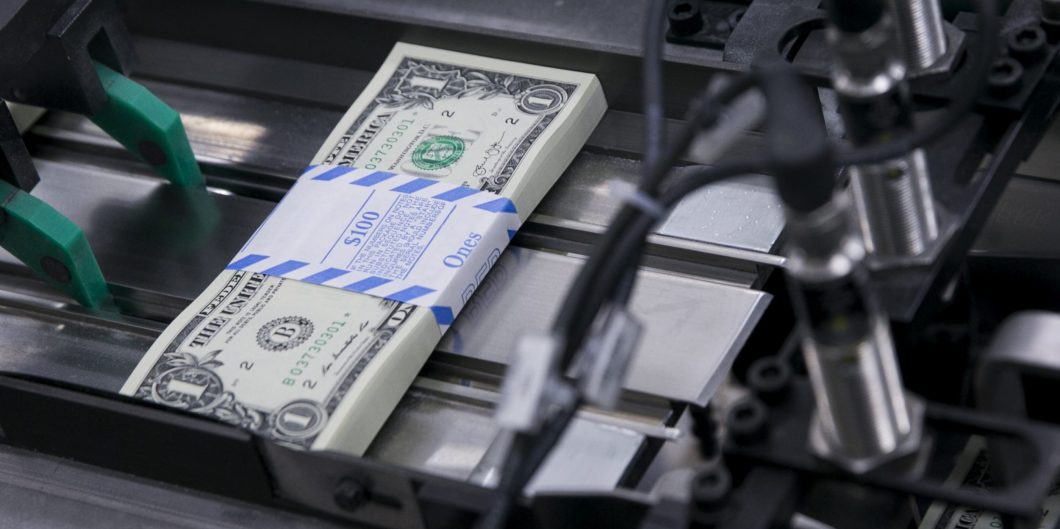An expert panel discusses debt and inflation.
Inflation Comes for the Profligate
Printing money to finance wars with resulting inflation is the most time-honored monetary policy. It can also be used for other crises thought of as analogies to wars, like to finance the massive expense of bridging the Covid 19-triggered bust of 2020.
In these situations, the central bank necessarily becomes the Treasury’s partner and servant, stuffing its balance sheet with government debt and correspondingly inflating the supply of money. This captures an essential mandate of every central bank, though it is not one you will find in the Federal Reserve’s public relations materials, namely lending money to the government of which it is a part.
Now, as the economic recovery from the Covid bust strengthens, soaring government debt is still being heavily monetized in the Federal Reserve’s balance sheet, which has now expanded to a previously unimagined $7.6 trillion, in a classic Treasury-Fed cooperation. The printing (literal and metaphorical) continues and the new administration wants to expand it even more. Isn’t accelerating inflation on the way?
The distinguished former Secretary of the Treasury, economist Larry Summers, recently suggested that it may be. “There is a chance,” he wrote, that government actions “on a scale closer to World War II levels than normal recession levels will set off inflationary pressures of a kind we have not seen in a generation.” I believe this is correct.
If we agree that there is such “a chance,” how big a chance is it? With political delicacy, Summers’ essay does not address this question. Instead, he carefully points out the “enormous uncertainties” involved. While the fog of uncertainty always obscures the economic future, it looks to me like the answer is that the chance is substantial. It would not be at all surprising to see inflation move significantly higher.
“There is the risk,” Summers writes, “of inflation expectations rising sharply.” Well, inflation expectations are already rising among bond investors and analysts, giving rise to such commentaries as these:
“According to the Bank of America’s January fund manager survey, some 92% of respondents expect rising inflation.” (Almost Daily Grant’s Newsletter, February 10, 2021)
“Bonds Send Message that Inflation is Coming” (Barron’s, February 5, 2021)
“For those of us not inclined to believe in free lunches, the funding of large deficits with printed money is another source of inflation and financial stability concerns” (Barron’s, February 12, 2021)
“A new worry now is whether the tremendous spending plans…can really be done without prompting a historic inflation.” (Don Shackelford, Proceedings newsletter)
“With growth in unit labor costs surging and a range of survey indicators also pointing to rising price pressures, we think inflation will be much stronger over the rest of this year.” (Andrew Hunter in Capital Economics)
“Inflation Worries Drive Platinum Up” (Wall Street Journal)
“The rat the Treasury market is smelling is consumer price inflation.” (Wolf Street, February 13, 2021).
Reflecting these concerns, the yield on the 10-year Treasury note, while still low, has risen meaningfully of late, to about 1.4 percent from 0.7 percent six months ago. This move has imposed serious losses on anybody who bought long-term Treasuries last summer and held them. The price of the iShares Treasury Bond ETF, for example, is down about 18 percent since the beginning of August.
In contrast to the views just quoted, Summers observes “administration officials’ dismissal of even the possibility of inflation.” Who is right, the investors or the politicians? Whose assessments of inflation risk do you believe? Politicians may be expected to deny an economic result that would get in the way of their intense desire to spend newly printed money.
As has frequently been discussed, a notable inflation has already been running for some time—the inflation in asset prices. Monetary expansion, needing to go somewhere, has gone into the prices of equities, bonds, houses, gold, and Bitcoin. The “Everything Bubble” stoked by the Federal Reserve and the other principal central banks has taken asset prices to historically extreme, and in the case of Bitcoin, amazing, valuations. Financial history presents an essential recurring question: How much can the price of an asset change? It also provides the answer: More than you think.
U.S. house prices have been and are inflating rapidly. They are substantially over their Housing Bubble peak of 2006. According to December’s Case-Shiller index, they are rising at an annualized rate of 10 percent, and AEI’s December Home Price Appreciation Index shows a year-over-year increase of 11 percent. This is abetted by the Fed’s monetization of long-term mortgages, of which it owns, including unamortized premiums, a striking $2.3 trillion—a sum 2.6 times its total assets in 2007—and which it continues to buy in size. This huge monetization of mortgages by the institution they created would greatly surprise the founders of the Federal Reserve, could they see it, and displease them. Instead of taking away the punch bowl as the party warms up, the Fed is now pouring monetary vodka into the housing finance punch. Reflecting on this inversion of the famous metaphor, Ed Pinto of the American Enterprise Institute has reasonably asked if they couldn’t at least stop buying mortgages. But it appears this will not happen anytime soon.
Of course, as a base line, we have endemic inflation of goods and services prices. The Federal Reserve has moreover formally committed itself to perpetual inflation. The Covid bust notwithstanding, the Consumer Price Index increased 1.4 percent year-over-year in January, 2021, and over the two months of December-January at an annualized rate of 3.1 percent. We are told frequently by the Fed about its “2% target” and hear it endlessly repeated by a sycophantic chorus of journalists. Since the Constitution unambiguously gives the power of regulating the value of money to the Congress, I believe the Federal Reserve acted unconstitutionally in announcing on its own, and carrying out without the approval of the Congress, a commitment to perpetual depreciation of the purchasing power of the U.S. currency.
Last year it formally added a new willingness to let inflation go higher than 2 percent for a while. How much higher and for how long nobody knows, including the Fed itself, but this willingness is consistent with a greater chance of accelerating inflation.
How much inflation is a sustained 2 percent? At that rate, average prices quintuple in a lifetime. The global movement among central banks, including the Fed, to trying for 2 percent inflation is a notable example of the changing intellectual fashions of central bankers. When serving as Federal Reserve Chairman, Alan Greenspan suggested the right inflation target was zero, correctly measured, and an inflation rate of zero was the long-term goal of the Humphrey-Hawkins Act of 1978. The distinguished economist, Arthur Burns wrote in 1957 that “our economy is faced with a threat of gradual or creeping inflation over the coming years.” He was right about that, except that gradual unexpectedly became galloping in the 1970s (ironically, when he was Fed Chairman).
“It is highly important that we try to…stop the upward drift of the price level,” Burns argued. Over time, “even a price trend that rises no more than 1 percent a year will cut the purchasing power of the dollar”—so much the more would 2 percent, he added. How ideas have changed. . Since the 1970s, we never are told about “creeping inflation” anymore. While Burns in the 1950s attacked 1 or 2 percent inflation, our current monetary mandarins strive for 2 percent forever and more than 2 percent for now. This increases the risk, consistent with Summers’ observations, that they will get more than they are bargaining for.
Economics is so little a science that economists can always be found on both sides of any question. This is certainly true of the debate about escalating debt, monetization, and the risk of accelerating inflation.
At 3 percent inflation, prices would multiply by 11 times in the course of a lifetime. We are always a little surprised at the result over time of relatively small changes in a compound growth rate like the average rate of inflation.
One of the key Keynesian arguments for inflation was that wages are sticky downwards, so that if real wages economically need to fall, you can make then go down by inflation instead. Over the decade prior to the Covid crisis, average U.S. hourly earnings for all employees were rising first at about 2 percent and later 3 or 3.5% percent a year. So a 2 or 3 percent inflation would sharply cut or wipe out real wage gains, at the same time as it imposes negative real returns on savers. Other items you will never see in the Federal Reserve’s public relations materials are its potent abilities to reduce real wages and punish savers.
“Throughout history, there’s absolutely no currency in the world that has maintained its value,” international fund manager Mark Mobius pronounced. The U.S. dollar certainly has not, losing 96 percent of its purchasing power since the creation of the Federal Reserve and losing 98 percent of its value in terms of gold since 1971. (That was when the U.S reneged on its Bretton Woods commitments and led the world into a pure fiat currency regime.) Increasing inflation going forward from here would be consistent with history.
Economics is so little a science that economists can always be found on both sides of any question. This is certainly true of the debate about escalating debt, monetization, and the risk of accelerating inflation.
With the opinion farthest from mine, we have the cheerleaders for monetizing a lot more debt and practicing “What, me worry?”—these are the proponents of “MMT” or Modern Monetary Theory. Of course, it should be written “M”MT, or “Modern” Monetary Theory, since solving your problems by printing up money and forcing the people to accept the depreciating currency is a very old financial idea. The City of Venice used it in 1630, for example, to spend with inflationary result during an attack of bubonic plague. Alternately, we could consider calling it “WMT” or “ZMT” for Weimar Monetary Theory or Zimbabwe Monetary Theory. Even better would be “JLMT” for John Law Monetary Theory.
John Law was the creative, persuasive theorist of risk and paper money, “secretary to the King of France and controller general of His Majesty’s finances,” who presided over first the inflation and then the panicked collapse of the Mississippi Bubble of 1720. A main theme, then as now, was how to produce paper assets to cover the government’s debts, but his history also provides a precedent for our house price discussion: “Thanks to Law’s money-printing, land and houses were expensive.”
Like the close ties of John Law to the French monarchy, the question of debt monetization and its inflationary risks is closely tied to the question of what kind of government we want. Should the federal government’s power be limited or expansive and dominant? What the proponents of “M”MT really long for is a vastly expanded and more powerful government, with themselves in charge. If debt can be indefinitely expanded by bloating the central bank, then you don’t have to tax much in order to spend forever. Thus one of the most important limits on the power of Leviathan to dominate the society can be removed. We see that much more is involved than a monetary theory.
Are those desiring to wield the expanded power willing to cause much higher inflation to get it? This is the political meaning of the monetary question.



